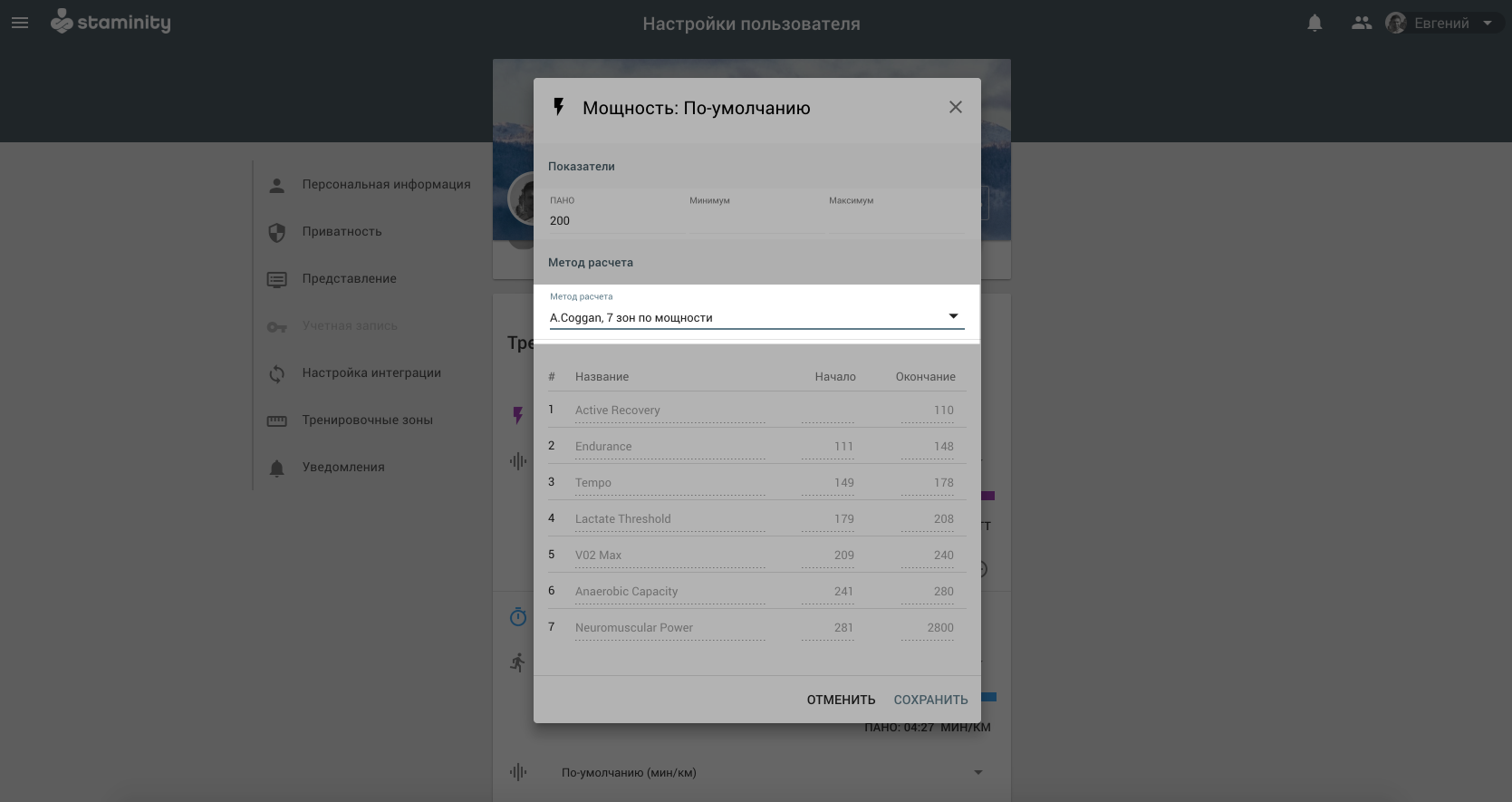Determining training zones
Training zones are intensity levels within which certain activities should be completed in order to achieve better training effect.
There are several popular methods of determining your training zones limits which differ in the number of zones, basis of their calculation and zones limits.
In Staminity we calculate intensity zones limits using the following methods:
HR zones
Pace/speed zones
Power zones
HR zones
Joe Friel method, 7 HR zones based on LT
In The Triathlete's Training Bible Joe Friel defines seven training zones which limits are calculated in percentage of athlete's LTHR, separately for running and cycling:
| Zones | Zones limits for running | Zones limits for cycling |
|---|---|---|
| Zone 1. Recovery | Up to 85% of LT | Up to 81% of LT |
| Zone 2. Aerobic | 85-89% of LT | 81-89% of LT |
| Zone 3. Tempo | 90-94% of LT | 90-93% of LT |
| Zone 4. SubThreshold | 95-99% of LT | 94-99% of LT |
| Zone 5.a. SuperThreshold | 100-102% of LT | 100-102% of LT |
| Zone 5.b. Aerobic capacity | 103-106% of LT | 103-106% of LT |
| Zone 5.c. Anaerobic capacity | More than 106% of LT | More than 106% of LT |
Data source: http://www.trainingbible.com/joesblog/2009/11/quick-guide-to-setting-zones.html
In order to calculate HR zones limits according to Joe Friel method you need to fill in LT value, select the corresponding method of calculation in zones settings and save changes: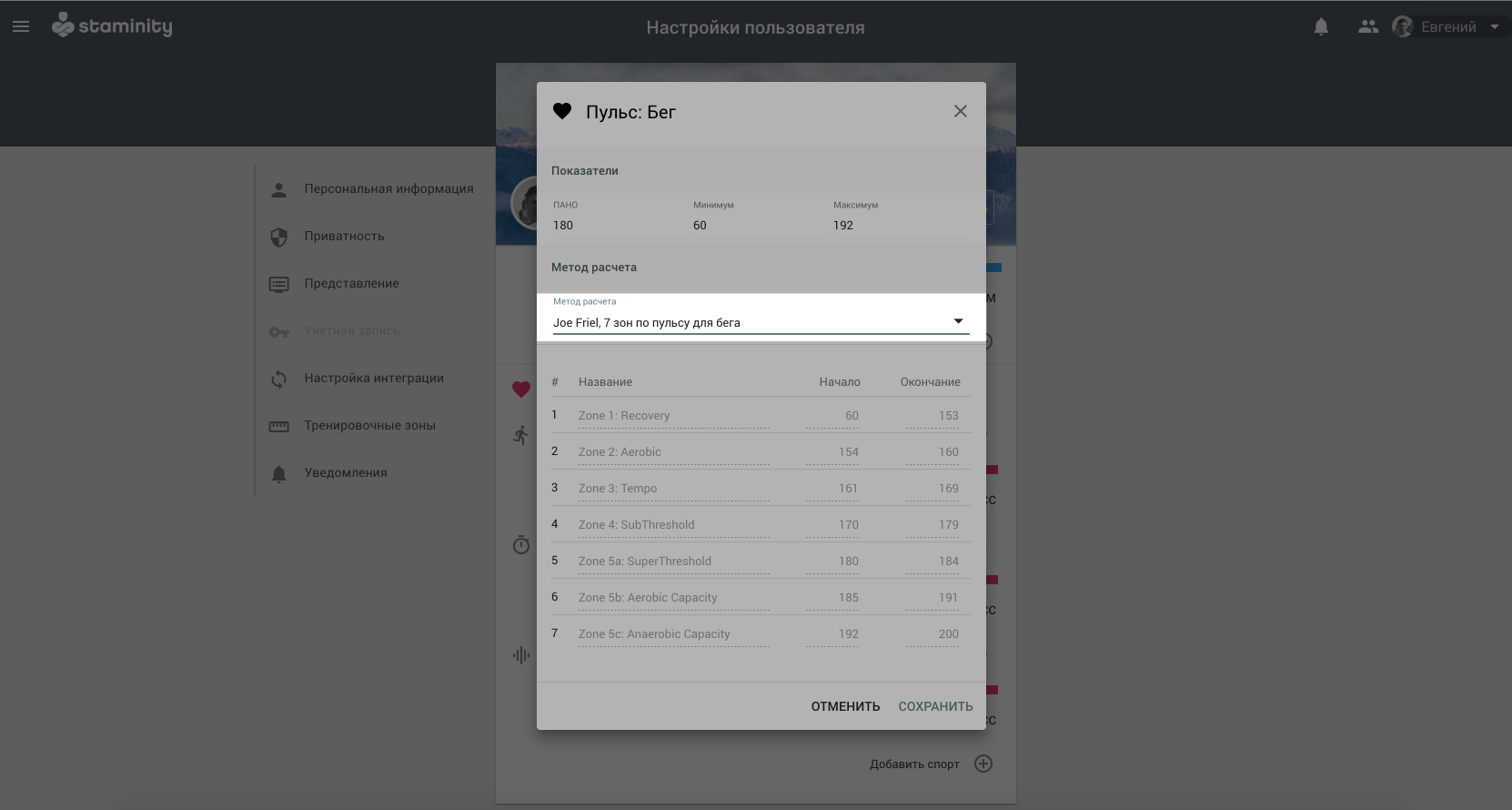
Recovery (zone 1). Activities within zone 1 limits include the most simple exercises helping experienced athletes to recover after hard exercises or a period of complex activities.
Extensive endurance (zone 2). This intensity type is characterized by long activities focused on endurance development. When completing exercises at such efforts level, formation and then maintenance of aerobic endurance take place. During such activities, lactate is produced in relatively small quantities, which allows to complete long, but at the same time, comfortable training sessions at the athlete's aerobic endurance limit (or a bit higher).
Intensive endurance (zone 3). With a minor increase in intensity, the production of lactate begins to increase compared to the previous levels, as in addition to the slow twitch muscle fibers, fast twitch ones spring into action.
Intensity threshold (zones 4 and 5a). Possibly, the most important training zone for all-round athletes. The efforts level here is slightly above or slightly below the LT. Thus, aerobic mechanisms are used to the full, the main load falls to slow twitch muscle fibers and body systems that produce energy. A significant part of it starts to produce thanks to anaerobic mechanisms; in the body there appear improvements associated with immunity to the effect of lactate and accelerated utilization of its decay products. Moreover, fast twitch muscle fibers start to show characteristics of the slow twitch ones. In order to separate efforts applied lower and higher the LT level, the intensity threshold is divided into two zones.
Anaerobic endurance (zone 5b). At this stage intensity level is higher than LT. Structured activities are typical for this zone. This stage facilitates growth and development of fast twitch muscle fibers and the body's ability to resist the effect of lactate and utilize it. Great volume of activities focused on anaerobic endurance development represents the most common reason of professional athletes' overtraining so these activities should be treated with caution, and they should be followed by a long period of recovery.
Power (zone 5c). Power development is not so important for all-round athletes. Except for situations when an athlete faces difficulties with muscle mass building or when he needs to use fast twitch muscle fibers to increase speed. Power development exercises should consist of short explosive intervals separated by long recovery periods.
Zone description data source: The Triathlete's training Bible by Joe Friel. Mann, Ivanov and Ferber publishing house, Moscow, 2011
Peter Janssen method, 6 HR zones based on HRmax
Peter Janssen in his book "Training Lactate Pulse-Rate" describes 6 intensity zones and calculates their limits in percentage of HRmax.
HRmax - the athlete's maximum heart rate occurred during testing in a laboratory or during a competition.
| Zones | HR zones limits |
|---|---|
| Zone R. Recovery | 60-70% of HRmax |
| Zone A1. Aerobic 1 | 70-80% of HRmax |
| Zone A2. Aerobic 2 | 80-85% of HRmax |
| Zone E1. Endurance 1 | 85-90% of HRmax |
| Zone E2. Endurance 2 | 90-95% of HRmax |
| Zone An1. Anaerobic1 | 95-100% of HRmax |
In order to calculate HR zones limits according to Peter Janssen method you need to fill in HRmax value, select the corresponding method of calculation in zones settings and save changes: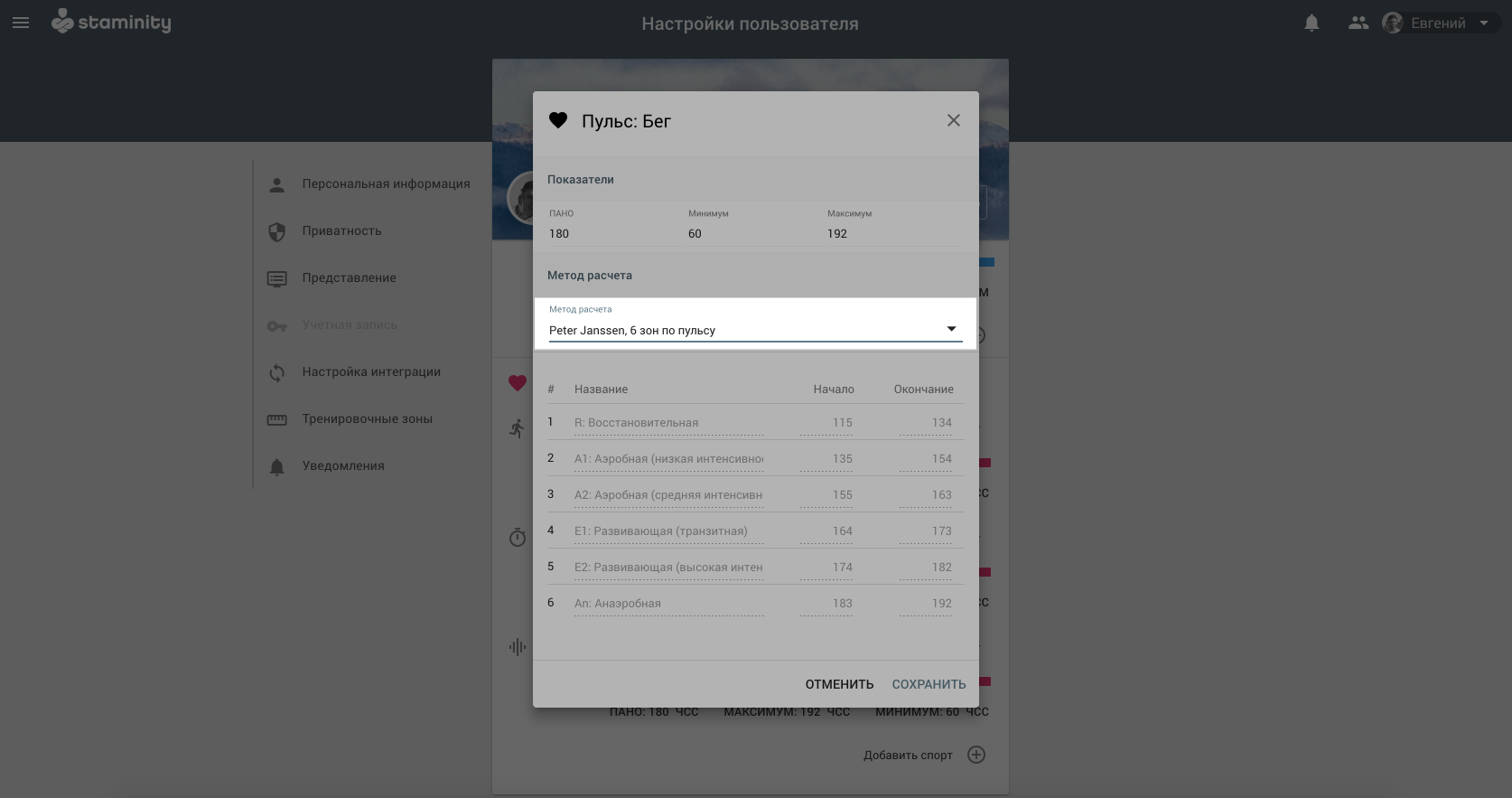
Zones marking:
- R - recovery zone. Very low intensity.
- A - aerobic zone. Is divided into two sub-zones with low (A1) and medium (A2) intensity. In aerobic zone energy is produced only thanks to aerobic processes.
- E - endurance zone. This zone lies a bit higher or a bit lower of the anaerobic threshold level, so energy is produced partly in aerobic and partly in anaerobic way. Also, two sub-zones are defined: E1 - transit zone, E2 - high-intensity endurance.
- An - anaerobic zone. Is based on anaerobic glycolysis, energy production occurs in conditions of insufficient oxygen supply, which leads to the formation and accumulation of lactic acid.
Martti Karvonen method, 5 HR zones based on HRreserve
Finnish physiologist Martti Karvonen offered to calculate intensity based on HRreserve, which is determined as HRmax - HRrest.
Based on it, 5 intensity zones are determined according to the following rules:
| Zones | HR zones limits |
|---|---|
| Zone 1 | HRrest + HRreserve* (50 - 60%) |
| Zone 2 | HRrest + HRreserve * (60 - 70%) |
| Zone 3 | HRrest + HRreserve * (70 - 80%) |
| Zone 4 | HRrest + HRreserve * (80 - 90%) |
| Zone 5 | HRrest + HRreserve* (90 - 100%) |
In order to calculate HR zones limits according to Martti Karvonen method you need to fill in HRrest and HRmax values, select the corresponding method of calculation in zones settings and save changes: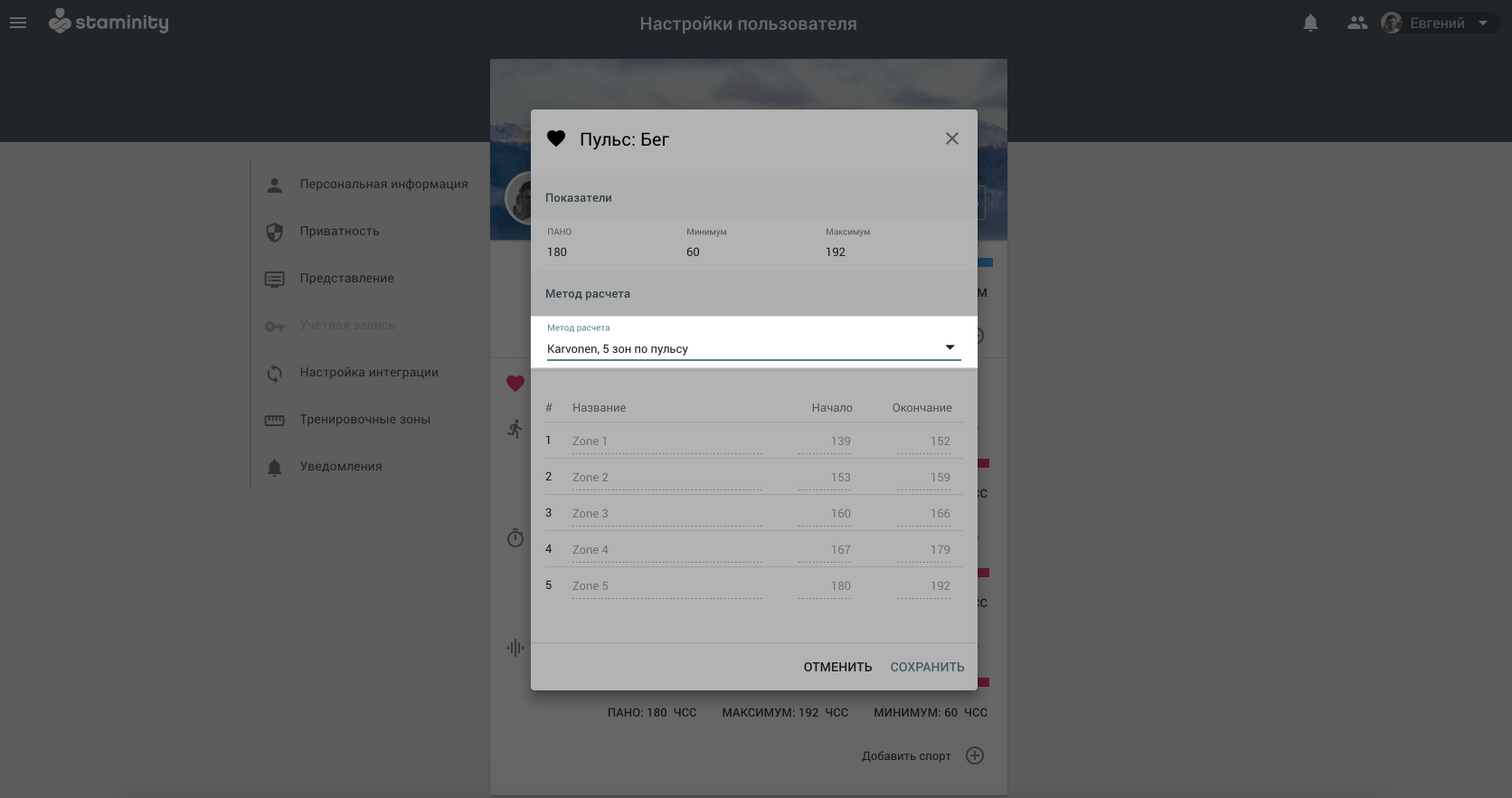
Pace/speed zones
Joe Friel method, 7 pace/speed zones based on LT
| Zones | Pace/speed zones limits |
|---|---|
| Zone 1. Recovery | Slower than 129% of LTPace |
| Zone 2. Aerobic | 114-129% of LTPace |
| Zone 3. Tempo | 106-113% of LTPace |
| Zone 4. SubThreshold | 101-105% of LTPace |
| Zone 5.a. SuperThreshold | 97-100% of LTPace |
| Zone 5.b. Aerobic capacity | 90-96% of LTPace |
| Zone 5.c. Anaerobic capacity | Faster than 90% of LTPace |
Data source: http://www.trainingbible.com/joesblog/2009/11/quick-guide-to-setting-zones.html
In order to calculate HR zones limits according to Joe Friel method you need to fill in LTPace value, select the corresponding method of calculation in zones settings and save changes: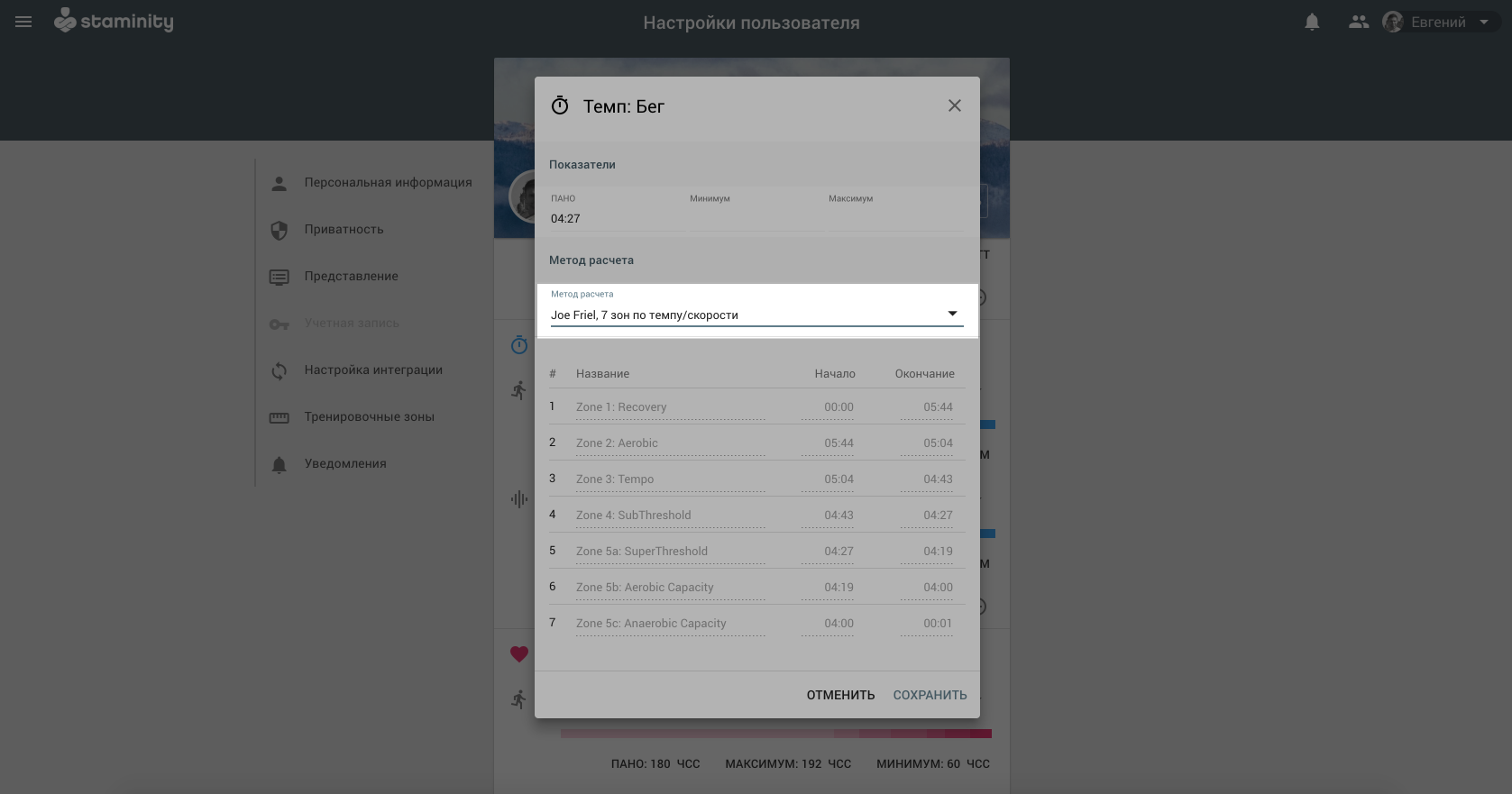
Zones description see in section Joe Friel method, 7 HR zones based on LT
Power zones
Andy Coggan method, 7 power zones based on LT
| Zones | Power zones limits for cycling |
|---|---|
| Zone 1. Active recovery | Lower than 55% of LTPower |
| Zone 2. Endurance | 55-74% of LT |
| Zone 3. Tempo | 75-89% of LT |
| Zone 4. Lactate threshold | 90-104% of LT |
| Zone 5. VO2 max | 105-120% of LT |
| Zone 6. Anaerobic capacity | 121-150% of LT |
| Zone 7. Neuromuscular power | More than 150% of LT |
Data source: http://m-ivanov.com/2016/08/kak-exat-bystree-sammari-na-knigu-trenirovki-po-moshhnosti-xanter-allen-i-endryu-koggan/
In order to calculate HR zones limits according to Joe Friel method you need to fill in LTPower value, select the corresponding method of calculation in zones settings and save changes: